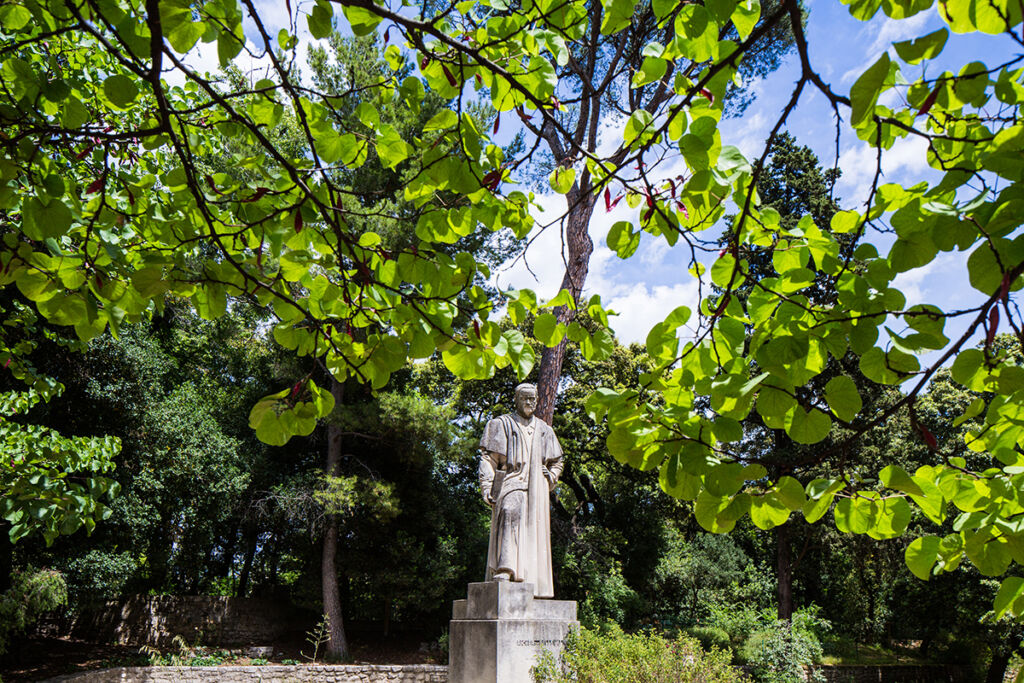Thierry Lavabre-Bertrand recounts the UM's heritage
Due to the health crisis, the 37th edition of the Journées du Patrimoine (Heritage Days), scheduled for September 19 and 20, has finally been cancelled in all state buildings, including those of the University. To replace this missed appointment, Thierry Lavabre-Bertrand, vice-president in charge of Heritage, takes you on a visit for the time of an article.

" Here I like everything," Thierry Lavabre-Bertrand answers with simplicity when asked what he likes best about this historic medical building over six centuries old. " See that wall [in the courtyard to the left of the Atrium]? It alone sums up the entire history of this fascinating place. " Indeed, a few remnants of medieval walls rub shoulders with the remains of the former cloister, where ancient ogival windows seem to open onto the scars of the Wars of Religion etched into the stone.
While the Faculty of Medicine as an institution celebrates its 800th anniversary this year, the historic building is just a century younger. " It was built in the 14th century to house a Benedictine monastery, and in 1536 became the episcopal see, before being plundered and ransacked during the Wars of Religion and abandoned for over a century. Renovated and enlarged under Louis XIV, the building began to take shape as we know it today. The grand vestibule, staircase and ceremonial rooms, among others, date from this period.
From clergy to science
However, it would take a revolution, and not just any revolution, to turn this place of worship into a medical school under the impetus of Jean-Antoine Chaptal in 1795. " This was the era of the Theatrum anatomicum, the prestigious library and the Salle des Actes, which replaced the former bishops' chapel. Of course, I took my thesis there, as our students still do today," recalls the former vice-president of the Faculty of Medicine.
He also remembers the Salle Dugès, where the busts now visible in the main hall once sat. " It was not only a lecture room, but also the vestibule of the anatomy amphitheater. It had been decorated in the 19th century with large frescoes intended to encourage students to meditate while waiting for class to begin. Too damaged, the frescoes disappeared in the 1980s during the renovation of the hall initiated by Dean Solassol. " At the time, the building was not yet listed [it will be in 2001], so we didn't have the religious respect we have today for traces of the past.
Winter medicine, summer botany
Let's cross Boulevard Henri IV to the Jardin des Plantes, another landmark of the UM's heritage. Founded in 1593, under the reign of Henri IV, by Pierre Richer de Belleval, then director of the anatomy and botany chair at the Faculty of Medicine, " the two were effectively linked. Anatomy in winter, because cadavers were better preserved, and botany in summer, when the trees are in bloom. That said, Richer de Belleval didn't like anatomy, and in fact never studied it," laughs Thierry Lavabre-Bertrand.
The oldest botanical garden in France, it was originally called the "King's Garden in Montpellier" (the Queen's Garden, still in existence, is an extension of this), and fulfilled several functions: " The medical garden was used to teach future doctors and apothecaries, the nursery was used to acclimatize and multiply plants, and a natural history cabinet housed remarkable specimens ", continues the vice-president. The garden continues to serve an educational function for students at the Faculty of Pharmacy. " The garden is currently home to more than 3,000 species over 4.5 hectares. It is maintained and run by a team of ten gardeners working around the director, the head gardener and the botanist ".
Serre Martins, Orangerie, Intendance and hidden labyrinth
Several areas make up the garden, starting with the Martins Greenhouse " named after the botanist who had it built in 1860 ". Renovated in 2011 thanks to support from the Languedoc-Roussillon region, it now houses an impressive collection of succulents. The Orangerie, meanwhile, provides shelter for plants in winter. " Built at the beginning of the 19th century, it follows the style of the Versailles orangeries, but in a revolutionary, simpler and more harmonious version. There are no coats of arms, only the signs of the zodiac on the pediment, referring to the cycle of the seasons ", notes the heritage specialist. Its renovation, made possible with the help of a corporate foundation, was completed in 2018.
Now it's the turn of the Intendance building, which served as the Rectorat from 1815 to 1980, to be rehabilitated. " We're looking forward to this project with great interest, as it could reveal some remarkable archaeological remains. Foremost among these is Richer de Belleval's mysterious labyrinth, which leads down to the water table beneath the Jardin des Plantes, and in which the famous botanist is said to have cultivated ferns and other plants that thrive on shade and humidity.
A living museum of "drugs
Closely linked to the Jardin des plantes, the droguier, located in the Faculty of Pharmacy, " is another emblematic place in our history, bearing witness to the city's long medical and pharmaceutical tradition ". Established at the end of the 16th century, it houses the second-largest collection, after the one in Paris, "with over 10,000 samples of plant, mineral and animal origin from all over the world, whose ethnopharmacological value remains inestimable", explains the vice-president. A living museum of the history of "drugs" and medicines, " it continues to be enriched on a regular basis by donations and bequests, and remains a very active center for education and research ".
This is where Thierry Lavabre-Bertrand takes us on a tour of the treasures and anecdotes that make up the University's heritage. Its walls will be enriched for another year, before we invite the public to join us again for the Journées du Patrimoine.